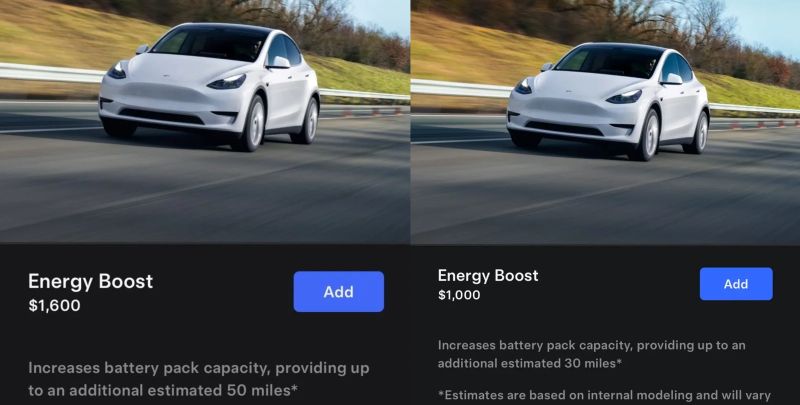Tesla improves the range and performance of Model 3/Y without changing the battery capacity
 Kevin WongJul 03, 2025, 03:52 PM
Kevin WongJul 03, 2025, 03:52 PM
 【PCauto】In the Chinese market, Tesla has recently improved the Model 3 and Model Y. While the industry peers usually opt to increase battery capacity to improve performance, Tesla took an unconventional approach: enhancing both range and performance by adjusting battery chemistry and software algorithms, all without changing the original battery pack.
【PCauto】In the Chinese market, Tesla has recently improved the Model 3 and Model Y. While the industry peers usually opt to increase battery capacity to improve performance, Tesla took an unconventional approach: enhancing both range and performance by adjusting battery chemistry and software algorithms, all without changing the original battery pack.
The CLTC-rated range of the updated Model 3 Long Range Rear-Wheel Drive has increased by 40 kilometers, from 713 km to 753 km. Its 0–100 km/h acceleration time has been shortened from 4.4 seconds to 3.8 seconds, delivering noticeably better performance. However, the upgrade also comes with a price increase of 10,000 RMB (approximately RM 5,900), bringing the new starting price to 285,500 RMB (around RM 169,000). The Model Y Long Range All-Wheel Drive has also seen its CLTC range increase, rising from 719 km to 750 km.

The cathode material composition of the battery has been optimized by Tesla engineers.
The migration efficiency of lithium ions during the charge-discharge cycle has been enhanced by raising the nickel content and modifying the cobalt to manganese proportion. Concurrently, the electrolyte additives' formula was improved, which led to an internal resistance decrease of about 3%.
Without changing the battery's physical dimensions or weight, these modifications were performed to same-spec lithium iron phosphate (LFP) batteries that CATL provided. Notably, the battery's working range has increased by 2% due to the Battery Management System's (BMS) better millivolt precision in voltage monitoring, which equates to an additional 1.5 kWh of useful energy discharged within the safe operating range.

Optimization of motor control through software
The permanent magnet synchronous motor's current waveforms have been recalibrated, increasing peak torque output efficiency by 4.7%. Braking energy conversion efficiency rose from 68% to 72% when the energy recovery system was upgraded. This means that about 0.8 kWh more energy was collected per 100 kilometers. A GPS-based preheating approach has been added to the thermal management system. This reduces energy loss while charging in Supercharger by proactively reaching the battery's ideal temperature range station.
Extended range potential was already present in the Model 3/Y.
Elon Musk stated back in May of last year that buyers may unlock the latent range capability of the Model Y units manufactured in recent months for a comparatively inexpensive price. Tesla responded by introducing a service called "Acceleration/Range Upgrade" on its website, which allows users of the Standard Range Rear-Wheel Drive (RWD) Model Y to unlock more range. Users can extend the range of their vehicles by roughly 48 to 85 kilometers by spending $1,000 or $1,600.

Clearly, the Model 3/Y has already had the potential for extended range—it’s just that Tesla hadn’t unlocked it until now for certain reasons.
If any infringement occurs, please contact us for deletion
Trending News

2026 Toyota Hilux Travo released, the brand-new exterior and interior are highly anticipated
If you're considering buying a Hilux, honestly, the comprehensive innovations in the ninth generation are worth waiting for. While the current model might still have some advantages in terms of reliability and price, the new model offers significant changes in terms of exterior and interior luxury, tech features, and powertrain options.

Perodua Traz VS Ativa, which one is more worth buying?
Traz, as a newly launched mid-sized SUV, offers more spacious room and mainstream power compared to small SUVs, but its pricing appears slightly higher than that of Ativa. Ativa, on the other hand, is Perodua's long-time best-selling small SUV with more affordable pricing and a balanced combination of power and tech features.

Which one is better, Honda City or Toyota Vios?
When choosing a compact sedan, Honda City and Toyota Vios are often two options that make people weigh repeatedly. You might be attracted to the dynamic design of the Vios but also be captivated by the City.

Perodua Myvi and Bezza may undergo major upgrades in 2026
After the update, the Bezza will no longer be just a low-cost alternative but a core model in the Perodua system with greater market competitiveness and brand premium potential. The upgrade of the Myvi is not to be unconventional but to strengthen the brand and market, ensuring that the Myvi continues to maintain its irreplaceable position in the new round of product competition.

Perodua Traz VS Toyota Yaris Cross, where does the Traz fall short?
Before the official launch of the Perodua Traz, market expectations were actually very high because it shares the same DNGA platform as the Toyota Yaris Cross. However, sharing the same platform does not equate to the same experience, and the Traz's final performance has indeed been disappointing. Perhaps it is precisely because of the delayed launch that it has almost no competitiveness in the current competitive environment.
Popular Cars
Model Year
Car Compare
Car Photo

